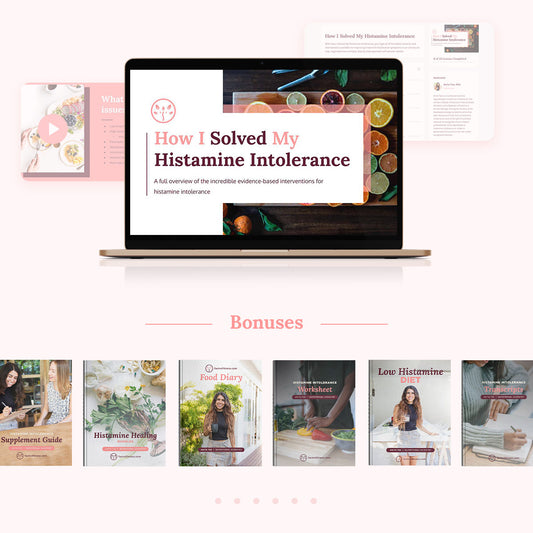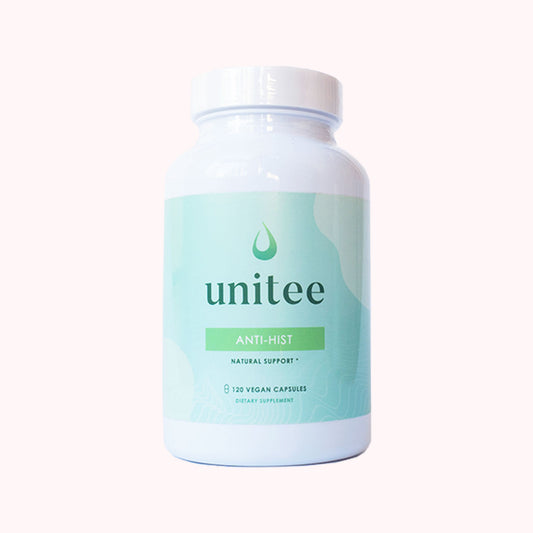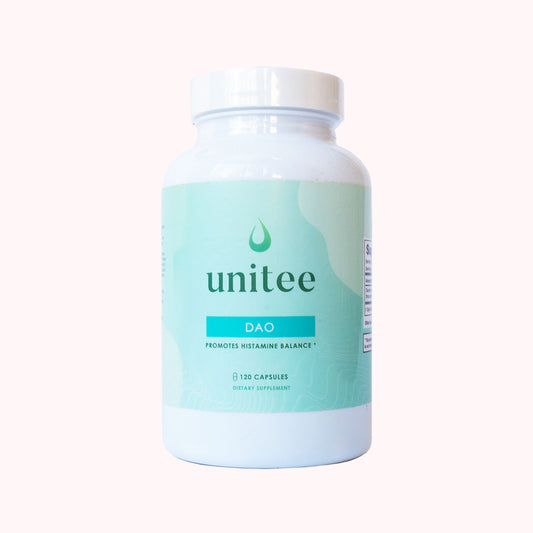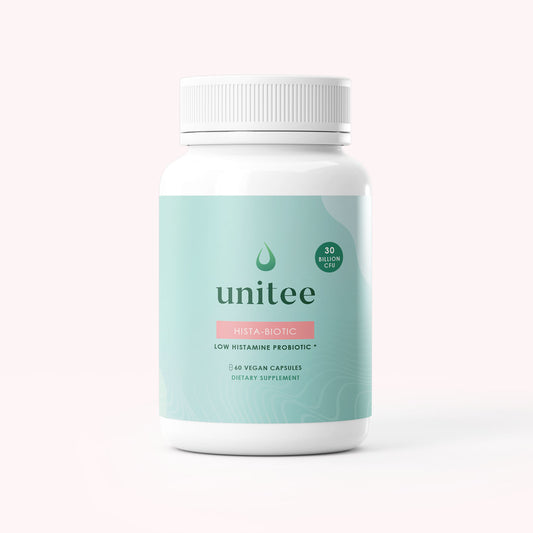Do you ever feel tired, dizzy and unwell just a short while after eating your last meal?
Do you feel like even though you’ve had a fairly good serving of a satisfying meal, and you really shouldn’t be hungry after eating that much, you just need to eat or you’re likely to start feeling like you’re about to ‘crash’?
These issues are more common than you think when you suffer from histamine intolerance.
But why is that?
Well, histamine has a way of tripping up your body’s ability to control your blood sugar… and, your blood sugar levels can also impact the amount of histamine your body releases (1).
Let’s take a closer look at this histamine and blood sugar phenomenon and, as always, what you can do about it to ensure it doesn’t lead to further complications with your histamine intolerance symptoms down the road.
Blood Sugar 101: What Is Blood Sugar and Why Is It Important?
First things first: what exactly is your blood sugar anyway?
Glucose is a simple sugar molecule that the body uses to create energy. It is the main source of fuel in the body, and it is transported to various tissues in the body via the blood. It's the compound that is measured in the blood to provide an indication of how much sugar you have in your body, and a blood test can measure what your blood sugar is (2).
Now, what is it about your blood sugar that you need to know about?
For starters, the amount of sugar in your blood plays a key role in health. Either too much or too little can pose problems. In our modern society, it's the former we often have to manage, where people present with the most health problems as a result of having too much sugar in the blood.
If you have too much sugar in your blood for long periods of time, it can create problems with the hormone insulin, which is the key to transporting sugar or glucose into your cells where it is used as energy. Insulin can become lazy when it has worked hard for many years, and it leads to a condition called insulin resistance. Insulin resistance prevents optimal transport of glucose into your cells, not only leaving your blood carrying more sugar than it should, but it also leaves your cells depleted of their primary source of energy.
Histamine Intolerance Can Affect Blood Sugar Regulation Through Restriction
Your blood sugar depends on the amount of energy your body extracts from foods and drinks, especially those that contain energy in the form of carbohydrates. Your blood sugar is also controlled by various complicated biochemical processes that take place within the body, but really, the main contribution to your blood sugar that we want to know about when we're talking about histamine intolerance, is the sources that come from the foods you eat.
When you're living with histamine intolerance, you're probably following a very restrictive diet, am I right? The trouble with this type of restriction is, when you do this for a prolonged period of time, you're likely not getting the right combination of nutrients your body needs to function. Outside of all of the good quality vegetables and fiber you're lacking, one of the main food groups you're likely restricting on is carbohydrates.
Of course, at first, the restriction will help... you may even feel the best you have in years without those bothersome foods in your diet. But, eventually, if you don't get enough food variety for months or years at a time because you're sticking to a few 'safe foods', you may develop nutrient deficiencies.
It’s at this stage that your brain says, "Right, I’m not getting what I need, so let’s get our hands on a quick and easily available source of energy!". What does this look like? Cravings for foods that can give you energy, of course!
These cravings often come in the form of high carbohydrate foods and easily available sugars.
Eating sugar or any other high carb food - and yes, this includes ‘histamine safe’ foods like coconut sugar, date syrup and maple syrup as well as high glycemic index fruit like grapes - causes your blood sugar to spike and crash multiple times a day. It’s likely the reason you feel so tired after eating, and it can leave you feeling less than well and simply wanting more sugar to feel better again.
But where does histamine come in?
When Your Blood Sugar Is Dysregulated, So Is Histamine
We know that histamine plays some major roles in the digestive process. Research has shown that it may impact the motility, or movement, of food through your digestive tract, enhance production of digestive juices, particularly stomach acid, but at the same time, actually reduce the ability of the protective mucosal cells in the digestive lining to regenerate (3).
Histamine is actually released every time you eat, and is important for the extraction of energy from your food.
So, you'd be correct in thinking the histamine released during and after a meal should make you feel worse. While you might feel better for a few minutes because your blood sugar is brought back up when you eat, you’ll likely feel much worse again soon after. Especially when you eat a higher glycemic meal.
What happens here is that the sudden rise and fall of your blood sugar causes a stress response in the body. And as you already know, a stress response causes histamine to be released from mast cells (4). Which means, your symptoms are not only brought on because of the rapid spike and drop in your blood sugar, but also because of the increase in your histamine levels.
It becomes a vicious cycle where you feel better by eating for a short time, and then feel worse, so you likely try to eat again. Then you feel worse... and so it goes!
This cycle is one of the reasons why I recommend limiting sugar sources, simple carbohydrates and even low-histamine sweeteners in my low histamine diet guide. The guide is much more than just a list of histamine allowed or restricted foods, but a holistic tool that takes into account all of the ways that eating may be impacting your histamine symptoms and overall health.
Histamine Intolerance and Blood Sugar Dysregulation Linked to Low DAO
There's another piece of the puzzle of histamine intolerance and blood sugar dysregulation to acknowledge.
Research has also shown many of those who are histamine intolerant also produce lower levels of the histamine degrading enzyme called diamine oxidase (DAO) enzymes (5). The reason this is incredibly relevant is because DAO enzymes are essential for breaking histamine down in the gut. Without enough of a supply of DAO, any histamine entering the body or being produced internally through various bodily functions taking place on a day-to-day basis, can likely lead to higher than tolerated histamine levels, which can cause chronic symptoms of histamine intolerance to develop. And when histamine levels are higher than they should be, it can cause blood sugar dysregulation.
And these factors really show why it's also common to find higher levels of histamine in the blood of those who have been diagnosed with diabetes; one condition simply perpetuates the other, leading to an aggravation of both syndromes (6)!
With this in mind, you can imagine the impact that a high sugar diet has on your health both in terms of managing your blood sugar levels as well as your symptoms of histamine intolerance. Essentially, continuing to eat a high sugar diet and/or high carb diet, could worsen your histamine intolerance symptoms, and also put your health at risk by increasing the likelihood that you may be diagnosed with diabetes.
Balancing your blood sugar is not only important for your health overall, but for ensuring that you don't continue to unknowingly worsen your symptoms of histamine intolerance.
How to Balance Blood Sugar When You're Living With Histamine Intolerance
It’s essential to try to put together well balanced meals every time you eat food. This means that you should be including a protein and/or fat source and low histamine vegetables in your meals, especially when you’re including carbs. Keep in mind, we're talking generally here as some individuals do have variances in personal tolerance for a variety of foods.
For example, if you have trouble with certain types of fiber, which would be more common for those of you with IBS or SIBO, then of course tailor the meal to go easy on the fiber and continue to add as many of those veggies you can tolerate. The point here is to keep these 'rules' in mind while still listening to your body and paying attention to how it responds.
Of course, we also encourage you to eat low glycemic index carbs, wherever possible. Or, if you’re only tolerating white rice as a carb, for example, be sure to eat a smaller portion and pair it with a good serving of protein and/or a small portion of fat to blunt the blood sugar spike that may come from eating a large amount of white rice on its own.
As an example, if you are going to have a bit of rice, try to limit it to 1/2-3/4 cup at one time, add a small portion of freshly cooked chicken breast equalling around 100g and cover it with 1-2 tablespoons of olive oil to ensure you have both the protein and fats components in the meal.
Add your favorite selection of low histamine vegetables to top it all off. Even though vegetables are not a calorie dense food, adding them to your meal is a great way to support your blood sugar. The high fiber content they contain helps to slow down the digestive process, leaving you with a more stable source of energy flowing from your meals into your blood.
Again, not everyone will have a super high tolerance to fibrous vegetables depending on the digestive issues you're facing, but if you can tolerate them, I highly encourage you to eat them at every chance you get. They're not only good for blood sugar control, they can actually improve your digestive and overall health by supporting the diversity of your gut bacteria.
If you really do need something sweet after the meal, opt for just a small portion of low histamine fruit, where possible, or select a whole-foods dessert sweetened with a natural sweetener such as maple syrup or coconut sugar, as opposed to any type of refined table sugar.
I find that my stewed apple recipe is a real winner among my clients, and it’s a delicious and healthy treat that also has gut-health promoting and inflammatory reducing properties.
If you’re in need of another source of sweetness in your diet, consider adding 100% pure, alcohol-free stevia in foods that require it. It has been shown to have little to no effect on your blood sugar, but provides the sweetness of sugar you may be looking for; as long as you use it once in a while just to satisfy that craving.
Long Term Control of Your Histamine Intolerance Isn’t About Restriction
The bottom line is that restrictive diets, followed over prolonged periods of time, can lead to sugar cravings. Even if you do feel better by eliminating whole food groups, if you're not nourishing yourself properly, it can lead to all sorts of problems. Even a low histamine diet, like the one I often recommend to my clients living with histamine intolerance, should be followed both temporarily and correctly. They should simply not be relied upon forever, repeating the same foods for extended durations. They're a tool to help you to manage your symptoms while you go about finding the underlying cause of your dysfunction.
If you begin to get cravings, know that your body is trying to tell you something. It's likely missing something, and it's important to address that. Simply giving in to your cravings on a regular basis can actually worsen your histamine intolerance symptoms, without you even realizing it's happening.
The best approach is to utilize these diets temporarily while focusing on a long term approach to heal your histamine intolerance for good, and be able to eat a varied diet with as little restriction as possible!
References:
- Wang, K., et al. Histamine Regulation in Glucose and Lipid Metabolism via Histamine Receptors. Am J Pathol. 2010 Aug; 177(2): 713–723.
- Mathew TK, Zubair M, Tadi P. Blood Glucose Monitoring. [Updated 2023 Apr 23]. In: StatPearls. Treasure Island (FL): StatPearls Publishing; 2024 Jan-. Available from: https://www.ncbi.nlm.nih.gov/books/NBK555976/
- Fabisiak, A., Włodarczyk, J., Fabisiak, N., Storr, M., & Fichna, J. (2017). Targeting Histamine Receptors in Irritable Bowel Syndrome: A Critical Appraisal. Journal of Neurogastroenterology and Motility, 23(3), 341–348.
- Wang KY, Tanimoto A, Yamada S, et al. Histamine regulation in glucose and lipid metabolism via histamine receptors: model for nonalcoholic steatohepatitis in mice. Am J Pathol. 2010;177(2):713-723. doi:10.2353/ajpath.2010.091198
- Mušič E, Korošec P, Šilar M, Adamič K, Košnik M, Rijavec M. Serum diamine oxidase activity as a diagnostic test for histamine intolerance. Wien Klin Wochenschr. 2013;125(9-10):239-243. doi:10.1007/s00508-013-0354-y
- Pini A, Obara I, Battell E, Chazot PL, Rosa AC. Histamine in diabetes: Is it time to reconsider? Pharmacol Res. 2016 Sep;111:316-324.

Anita Tee
My name is Anita Tee. I'm a nutritional scientist who specializes in histamine intolerance. I hold a Master of Science in Personalized Nutrition and a Bachelor of Science in Human Biology and Psychology. For the past ten years, I have used my experience in nutritional and medical health sciences to create a scientifically backed, natural approach to healthcare that relies 100% on evidence-based research. As I previously suffered from - and overcame - histamine intolerance, my focus is to increase recognition and expand the available resources and protocols available for resolving this particular disorder. To date, I have helped over 4,000 individuals fully resolve or better manage their histamine intolerance symptoms.







